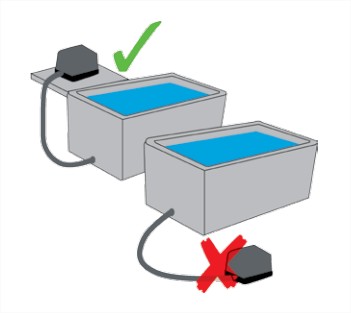Retrouvez ici les indispensables et meilleures ventes pour nos propriétaires de bassin.
Retrouvez ici les indispensables et meilleures ventes pour nos propriétaires de bassin.

How to choose the location of the air pump in the pond? This question may seem trivial to experts, but it is an excellent point to address for a beginner! Beyond the aesthetics offered by the bubbles rising from the bottom of the pond, air pumps have a much more important role.
They are one of the best alternatives for introducing oxygen into the body of water. And for good reason, fish, plants and good bacteria can only develop well in an environment that has a good oxygen content. The result? A balanced, healthy and algae-free pond!
⭐ This may interest you: keep an eye on your parameters! Find our guide to analyzing pool water !

First of all, the pump must always be installed above the water level, and at least 10 cm above the foundations. Such placement helps avoid a siphon effect when the pump is stopped, which will cause water to pass through the pump system and overflow through the suction.
If the pump cannot be placed at a higher level, it will be imperative to use one or more non-return valves . Otherwise, the backflow of water can cause a short circuit or the complete destruction of the pump.
Next, make sure that the air pump is placed horizontally, on a stable platform. If it is installed on an unstable base, vibration noises may appear. This also helps to avoid radial stresses on the membranes, which particularly affect the service life of certain components of the pump.

Finally, it should be noted that there is not yet a model of air pump that can remain unprotected outside. If you do not have a dedicated room, you will therefore need to provide a shelter to protect it from rain and bad weather. And in addition, these pumps do not withstand temperatures below -10°C: another reason to prepare a shelter!
If you already have a garden shed, this will do the trick even if it is a little far from the pond. In the case of air pumps, the length of the pipes has little effect on the flow rate.
Air pumps are electrical devices, generally equipped with a flexible membrane and two valves. We will therefore have an inlet valve and an outlet valve. In simplified terms, these devices are used to "bring" oxygen to the pool. They therefore keep the oxygen saturation of the water at an optimal level.

Among other natural phenomena and mechanisms, gas exchanges between water and the surrounding air are essential for the health of the inhabitants of the pool. Thus, in addition to providing oxygen, the bubbles propelled by the air pump also optimize the expulsion of gases harmful to living beings.
Air pumps are used in both warm and cold seasons. The slight difference is that in winter, the pump has an additional, very practical function: the air bubbles help to maintain a hole in the ice and thus allow harmful gases to escape.
When trapped under the ice layer, these harmful gases are the leading cause of mortality for fish and amphibians during the winter season. A simple opening in the ice can already limit this problem.
On the other hand, a compressor gives a significantly higher pressure than an air pump which is not useful, moreover, it also consumes much more energy
Under no circumstances should you use a compressor because it uses oil to lubricate the bearings and the piston. Oil mixed with water will inevitably end up in the water in your pool, causing pollution.
A favourable ambient temperature ensures the longevity of the air pump's diaphragms and valves. Therefore, care should be taken to ensure that the pump is well ventilated, especially in difficult operating conditions.
If the pump is mounted in a box, it will be necessary to provide a sufficient cooling system to prevent the device from overheating. For example, ventilation slots can be made to optimize the circulation of ambient air.
Some devices, such as Secoh pumps, are much more weather resistant. However, they should not be directly exposed to snow, sunlight or rain.
Air pumps should not be operated in dusty environments, and humidity levels should not exceed 90%.
A clogged filter has a major impact on the operation of the pump and can cause overheating.
Finally, care must be taken to ensure that flammable gases and other aggressive vapors do not enter the air intake passage. This leads directly to the electrical parts.
Aquipond Greenstab - Natural treatment against pond algae It is a natural product that helps limit algae at any time. It also has a prevent...
View full detailsReduces the layer of silt in the pond by at least 40% Easy to use with less impact on biodiversity Prevents fermentation, bad odors. pH ...
View full detailsOrganic dye to block plant growth by limiting photosynthesis ORGANIC PRODUCT NON TOXIC TO HUMANS (DIVING) AND FISH. 100% NATURAL AND BIODE...
View full detailsThe positive effects of barley straw have been known to water enthusiasts for a long time. But currently barley straw is difficult to find and i...
View full detailsReduces at least 40% of the layer of silt in the pond Easy to use with less impact on biodiversity Prevents fermentation, bad odors. ...
View full details
Comments
Leave a comment